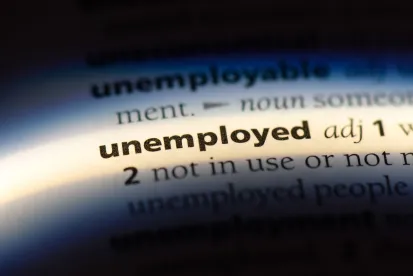The U.S. Department of Labor (DOL) recently published two additional Unemployment Insurance Program Letters (UIPLs) providing guidance on the administration of the expanded unemployment insurance benefits under the CARES Act. The following summarizes the key points of these UIPLs.
UIPL No. 15-20 addresses the Federal Pandemic Unemployment Compensation (FPUC) provision of the CARES Act, under which eligible individuals will receive an extra $600 per week, in addition to the weekly benefits amounts they otherwise are eligible to receive, for weeks of unemployment ending on or before July 31, 2020.
Who is eligible for the extra $600 FPUC payments?
Individuals receiving regular unemployment compensation under state programs; Pandemic Emergency Unemployment Compensation (PEUC); Pandemic Emergency Assistance (PUA); Extended Benefits (EB); Short-Time Compensation (STC); Trade Readjustment Allowances (TRA); Disaster Unemployment Assistance (DUA); and Payments under the Self-Employment Assistance (SEA) program.
FPUC is not available for those receiving benefits under state “additional benefits” programs, which extend the duration of benefits during high unemployment to those in approved training programs who have exhausted benefits for a variety of reasons.
Notably, individuals are entitled to the full $600 FPUC weekly payment if they receive at least $1 in a qualifying week under any of the above programs. This means that eligible individuals receiving partial unemployment benefits (such as those working reduced hours) under a state program are entitled to the full supplemental $600 weekly benefit.
When is the extra $600 payment available?
FPUC is available from the week of unemployment starting on or after the date on which the applicable state enters into an agreement with the DOL through the week of unemployment ending on or before July 31, 2020. If a state is unable to immediately pay FPUC benefits in the week following the execution of its agreement with the DOL, then the state must provide retroactive payments to those eligible for FPUC for those missed weeks.
Who funds FPUC benefits?
FPUC is 100% federally funded. States are not allowed to charge employers for FPUC benefits.
How do individuals find out if they are eligible for FPUC?
States must notify an individual of his or her entitlement to FPUC. The notification must include both the beginning and ending dates for the FPUC program. States have flexibility in how they provide this notification.
Individuals do not need to separately apply for FPUC.
How will FPUC be paid?
States have flexibility, but can pay FPUC either at the same time and in the same manner as the same week’s other unemployment compensation or in a separate payment on the same weekly basis.
UIPL No. 16-20 provides guidance on the Pandemic Unemployment Assistance (PUA) provision of the CARES Act.
Who is eligible for benefits under PUA?
PUA expands coverage to certain workers who traditionally are not eligible for unemployment benefits under state law, including individuals who are self-employed, independent contractors, or have exhausted regular unemployment benefits, among others, and are unemployed due to COVID-19 related circumstances.
UIPL No. 16-20 provides additional examples of what may constitute a qualifying COVID-19 related circumstance for PUA eligibility, including, inter alia:
- An individual has quit a job as a direct result of COVID-19 because the individual has been diagnosed with COVID-19 and continuing work activities (such as through telework) is not possible by virtue of the diagnosis or condition;
- An individual is “providing care” for a family member or member of the individual’s household who has been diagnosed with COVID-19 and the provision of care requires “such ongoing and constant attention that the individual’s ability to perform other work functions is severely limited”;
- An individual is the primary caregiver of a child or household member who is unable to attend school or another facility that is closed due to COVID-19. Notably, this includes an individual whose job allows for telework, but where the provision of care to a child or household member requires such “ongoing and constant attention that it is not possible for the individual to perform work at home”;
- An individual is unable to reach his or her place of employment because doing so would require violating a state or municipal order restricting travel that was instituted to combat the spread of COVID-19;
- An individual’s immune system is compromised by a serious health condition and he or she has been advised by a health care provider to self-quarantine in order to avoid the greater-than-average health risks the individual might face if he or she were to become infected;
- An individual was scheduled to commence employment, but no longer has a job because the employer rescinded the job offer as a direct result of COVID-19;
- An individual was diagnosed with COVID-19 by a qualified medical professional and, although the individual no longer has the virus, the illness caused health complications that render the individual “objectively unable to perform his or her essential job functions, with or without a reasonable accommodation”;
- An individual’s place of employment is closed due to an emergency declaration or “necessarily social distancing protocols” resulting from COVID-19; or
- An individual works as an independent contractor with reportable income and is unemployed, partially employed, or unable or unavailable to work because the COVID-19 public health emergency has severely limited his or her ability to continue performing customary work activities, and has thereby forced the individual to suspend such activities. For example, a driver for a ridesharing service may qualify for PUA benefits if he or she has been forced to suspend operations as a direct result of the COVID-19 public health emergency, “such as if an emergency state or municipal order restricting movement makes continued operations unsustainable.”
UIPL 16-20 further states, however, that many of the qualifying circumstances for PUA benefits “are likely to be of short term duration.” For example, the UIPL explains that a child’s school will not be “closed as a direct result of COVID-19,” for purposes of PUA benefits, after the date the school year was originally scheduled to end.
PUA benefits generally are not available to individuals who have the ability to telework with pay, or who are receiving paid leave benefits (including sick leave). However, an individual who is receiving paid leave benefits for less than his or her customary work week, or is teleworking with pay for less hours than the individual worked prior to the COVID-19 pandemic, may still be eligible for a reduced PUA weekly benefit amount.
When are PUA benefits available?
States may begin making PUA payments after they have entered into an agreement with the DOL, but PUA claims may be backdated to February 2, 2020 (the start of the “Pandemic Assistance Period”), if the individual meets PUA’s eligibility requirements. PUA is unavailable for weeks of unemployment ending after December 31, 2020.
Because the phrase “week of unemployment” is defined as ending on different days of the week under different states’ laws, the precise start and end dates for PUA benefit availability will vary slightly state-by-state. For example, in states where a week of unemployment ends on a Saturday, the last compensable week for the PUA program is the week ending December 26, 2020, whereas in states where the week of unemployment ends on Sunday, the last compensable week for the PUA program is the week ending December 27, 2020.
How will PUA claims be processed and administered?
PUA claims generally will be subject to the same filing and determination procedures as regular unemployment benefits under applicable state law.
When processing PUA claims, states are required to verify that individuals are not entitled to regular unemployment insurance benefits. If an individual’s eligibility for regular unemployment is questionable (for example, if there are wages in the base period but no claim is filed, or a job separation that has not been adjudicated), then the state must first require the individual to file a regular employment insurance initial claim. If the individual is subsequently disqualified from regular benefits, then the state may consider the individual for PUA eligibility.
Who funds PUA benefits?
The federal government will pay 100% of PUA benefits paid to eligible individuals by the state.
* * *
In light of the DOL’s latest guidance, we anticipate that states will begin to implement their own procedures and processes for administrating these new unemployment benefits. Employers and claimants should monitor the websites for any applicable state unemployment insurance programs for up-to-date guidance





 />i
/>i
